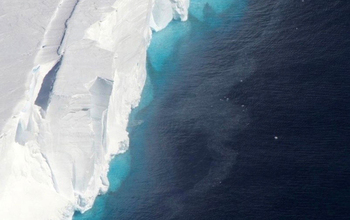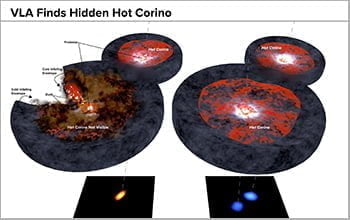_f.jpg)
Research News
Monsoon brings torrents of water that recharge groundwater aquifers
August 1, 2018
Find related stories on NSF’s Long-Term Ecological Research program site.
The summer monsoon season in the deserts of the Southwest U.S. is known for bringing torrents of water, often filling dry stream beds and flooding urban streets.
A common misconception, however, is that most of the water is swept away into large rivers, with very little percolating into underground aquifers.
Using a combination of field instruments, unmanned aerial vehicles and a hydrologic model, a team of researchers affiliated with Arizona State University (ASU) and the National Science Foundation (NSF) Jornada Basin Long-Term Ecological Research (LTER) site has been studying monsoon rainfall and its impact on groundwater recharge in the Chihuahuan Desert of New Mexico.
Jornada Basin is one of 28 NSF LTER sites located in ecosystems from salt marshes to forests, coral reefs to arctic tundra.
In their study, the scientists focused on measuring hydrologic and ecological conditions on piedmont slopes, locally known as bajadas, which connect mountain ranges with river valleys. Bajadas have often been ignored as sources of groundwater recharge.
“The future of water resources for humans and wildlife is uncertain,” says John Schade, a program director in NSF’s LTER program, which funded the research. “Studies like this are essential to proper water management in the face of rapid environmental change, especially in arid lands where water is scarce.
“This project is an example of the critical role long-term research plays in uncovering what controls the availability of fresh water. It advances our ability to forecast how freshwater availability will change in the years and decades to come.”
The findings, recently published in the journal Water Resources Research, demonstrate that a surprising amount of rainfall, nearly 25 percent, from monsoon storms is absorbed into small stream beds and percolates into the groundwater system.
“The results show that monsoon storms serve an important role in recharging groundwater aquifers,” says ASU hydrologist Enrique Vivoni. “This is an essential process that banks renewable surface water for future use as a groundwater resource in the arid Southwest and throughout the world.”
Fieldwork leads to new insights
From 2010 to 2018, the research team, which included collaborators from New Mexico State University and the U.S. Department of Agriculture, collected data from a watershed monitoring network established at the Jornada LTER site.
Lead author Adam Schreiner-McGraw of the University of California, Riverside, visited the site every three weeks for more than six years to collect hydrologic data, maintain an extensive instrument network, and carry out the sampling needed to test the hydrologic model.
“In hydrology,” says Vivoni, “you have to wait for certain conditions to occur. We benefitted from having a sequence of wet summer monsoons that delivered above-average rainfall.”
The team collected high-resolution data on rainfall, streamflow, soil moisture and evapotranspiration — the transfer of moisture into the atmosphere through surface evaporation and transpiration by plants. Schreiner-McGraw found that large rainfall amounts, especially during monsoons, were not being lost to the atmosphere through evapotranspiration or from the watershed channel system as streamflow.
Instead, runoff was being lost as percolation, or filtering through soil and rock, in channels smaller than 2 feet wide — an unexpected finding.
Simulating where water goes
By tracking the fate of monsoon rainfall, the researchers set out to explain how hillslopes and channels of the piedmont slope might lead to groundwater recharge.
“Soils on hillslopes are very different than those in channels,” explains Schreiner-McGraw. “They’re compact and don’t absorb water very quickly, and they have calcium carbonate layers about 12 to 20 inches below the surface that limit infiltration. Channels, on the other hand, have coarse and permeable sediments that can absorb water much more quickly.”
That information from the fieldwork was used to modify a hydrologic model of the watershed. The team tested the model with long-term data, including evapotranspiration, soil moisture, streamflow and percolation.
“It’s uncommon to have a hydrologic model tested so thoroughly,” says Vivoni. “By performing field observations and model developments, we demonstrated the value of long-term research.”
The findings are applicable to arid piedmont slopes anywhere on Earth. With water an increasingly precious resource, a better understanding of how groundwater is recharged could help communities across the globe.
“Understanding the groundwater recharge process in arid regions can help us sustainably manage groundwater use in these settings,” says Schreiner-McGraw.
Adds Vivoni, “Groundwater is like a bank account. Underground aquifers can store water delivered from surface systems, which can then be extracted in periods of water scarcity.”
Effects of vegetation change
The Chihuahuan Desert, like many areas in the Southwest U.S., is undergoing a transition in vegetation communities from grasslands to shrublands.
“We’ve historically used large open areas of the western U.S. and northern Mexico for livestock grazing,” states Vivoni. “As a result, many grasslands have disappeared and been replaced by desert shrubs.” In addition, drought and fire suppression have contributed to the conversion of grasses to shrublands.
A question remains: Has this transition impacted the groundwater recharge process in piedmont slopes?
“We examined how the watershed contributes to groundwater recharge under current conditions,” says Schreiner-McGraw. “The next step in the research is to determine how these contributions would be altered with different plant communities.”
—
Cheryl Dybas,
NSF
(703) 292-7734 cdybas@nsf.gov
—
Karin Valentine,
ASU
(480) 965-9345 karin.valentine@asu.edu
-
A launch pad for one of the unmanned aerial vehicles used in the study.
Credit and Larger Version -
An eddy covariance tower, which measures water transfer from land to atmosphere.
Credit and Larger Version -
A flume tracks streamflow at the outlet of the NSF Jornada Basin LTER site’s watershed.
Credit and Larger Version -
A cosmic-ray neutron soil moisture sensor measures the average soil moisture of the watershed.
Credit and Larger Version -
Instruments track rainfall and other variables at the Jornada LTER site.
Credit and Larger Version
Investigators
Hugh Monger
Niall Hanan
Debra Peters
Kris Havstad
Brandon Bestelmeyer
Stephanie Bestelmeyer
Related Institutions/Organizations
New Mexico State University
Related Awards
#1235828 LTER: Long-Term Research at the Jornada Basin (LTER-VI)
Total Grants
$5,929,998
Source: NSF News
Brought to you by China News













